One of the games on my watchlist after Gen Con was the Pathfinder Adventure Card Game from Paizo. I’d played the short demo version at the con and then again at PAX Prime a couple of weeks later. I interviewed designer Mike Selinker about it as well, and now I’ve finally gotten a chance to play the actual game. Paizo sent me a review copy of the base set, and since then I’ve played it many times (often multiple times in one sitting). It’s engaging and addictive, and I find myself thinking about it between sessions–to the detriment of all the other games I should be reviewing, unfortunately.
Now, the game isn’t perfect: there are errors in some cards (the list of errata in the FAQ is quite long) and I’ve seen some inconsistency in the card backs. There isn’t much flavor text for players who like a bit more story, and there’s also a lot of very tiny text that can make it hard on your eyes. However, I think the fun factor is high enough that I can still wholeheartedly recommend it for the right crowd. (Hint: if you’re here, reading a GeekDad game review, there’s a good chance you might be included in said crowd. Read on to find out!)
Let me start by saying that I haven’t played role-playing games, so my knowledge on this subject is a little hazy. Pathfinder started as a role-playing system based on Dungeons and Dragons 3.5, and it has been around since 2009. The world and characters should seem fairly familiar to anyone versed in the traditional fantasy genre: fighters and wizards, dwarves and orcs, elves and goblins. The Pathfinder RPG system uses “adventure paths,” in which players can follow a pre-written adventure, making it easier on game masters who no longer have to assemble their own adventures.
I’m more of a board and card gamer–I have a general understanding of how role-playing games work mechanically and I like the concept, but I’m not great at the actual role-playing portion of it. That’s probably what makes the Pathfinder Adventure Card Game (ACG) such a good fit for me. It uses the same characters and even adventure paths as the role-playing game, but it’s a card-and-dice game that doesn’t require a game master. Each scenario takes about an hour or so to play, which is also quicker than your typical RPG session, and although you can role-play your characters if you wish, that’s entirely optional.
Essentially, the Pathfinder ACG is kind of like role-playing for card gamers. I can imagine that existing fans of the Pathfinder franchise will appreciate a new approach to a familiar world, but for me it has been a great way to discover the Pathfinder world in an easy-to-digest format.
What’s Inside
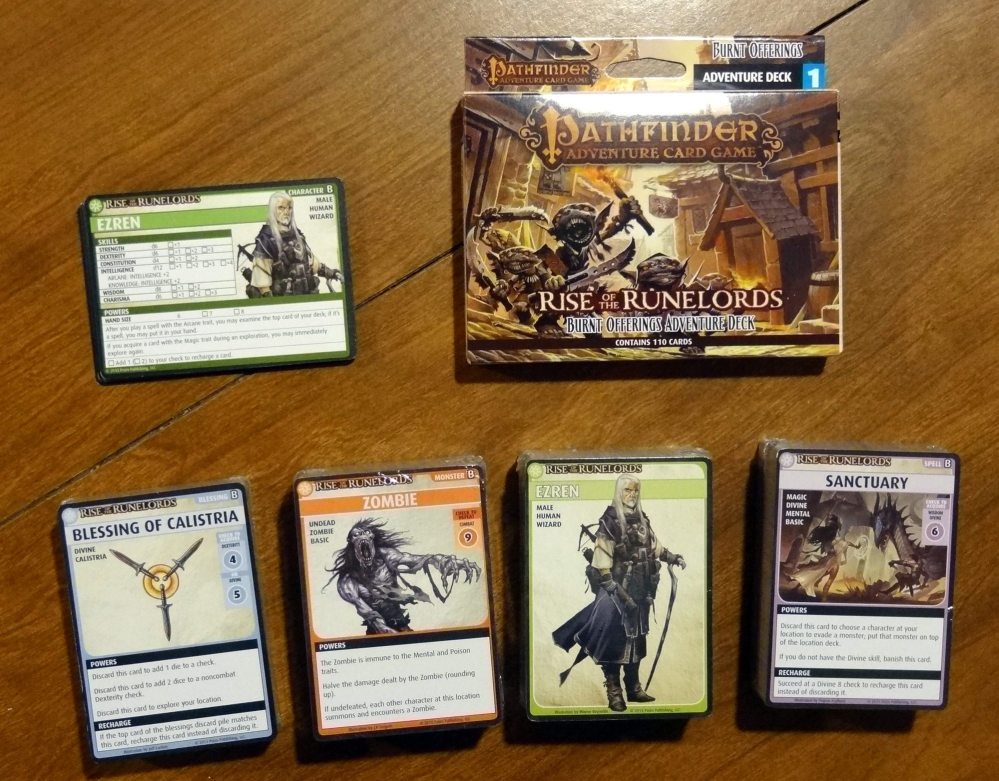
The Pathfinder ACG comes in a big box called Rise of the Runelords–that’s actually the first adventure path. The way it works is that the adventure path is a complete storyline, which parallels the RPG. Each adventure path comprises a number of adventures, which in turn are made up of multiple scenarios. The base set comes with nearly 500 cards, which is enough to play through a mini adventure path called Perils of the Lost Coast as well as the first adventure, Burnt Offerings. Perils of the Lost Coast just has three scenarios to get you started, and Burnt Offerings has five.
There are seven characters, plus a lot of locations, monsters, villains, henchmen, barriers, weapons, spells, armors, items, allies, and blessings. You also get a set of polyhedral dice: d4, d6, d8, d10, and d12. There are five more planned adventure decks to finish out Rise of the Runelords, and there’s room to store the whole shebang in this box, which is partly why it’s so large. There’s also room for the optional Character Add-On deck, which adds four more characters and enough of the base cards so that you can play up to 6 players.

The box has a plastic divider that lets you organize all of the different types of cards, as well as a section to store up to six character decks–that’s how you “save” a character from one session to the next, keeping the same set of equipment, spells, and so on. The manual has a handy guide to the layout. At first I thought I’d need to print labels for the sections, but after the first couple of plays I found it pretty easy to remember where everything goes. Besides, you don’t ever pull out all of the cards at one time, so each individual set of cards is easy to replace.
The one oddity is the section for the adventure decks. There’s a slanted section for you to store those (and the character add-on) but when you break open the adventure decks you’ll take the cards from those boxes and shuffle them into the corresponding stacks in the rest of the box. I suppose it’s just so you have your original adventure deck boxes for later, but it seems to take up more space than necessary. Time will tell.
There’s not much to say about the dice–they’re blue polyhedrals–but I do have a few comments about the cards. The artwork on them is nice (and may be familiar to those who have played other Pathfinder games) and for the most part the card text is straightforward so you can figure out how any given card works. However, there’s that errata I mentioned earlier: there are mistakes and errors which you’ll definitely want to look up, and in those cases you’ll need to decide if you’re going to mark those corrections directly on the card or what. Some things are minor: a henchman that should have the “Goblin” trait, a spell that shouldn’t say “Basic” on it. Others are more problematic: a spell recharge that should be 4 but says 14 makes it much more difficult. Some cards can only be played on yourself but don’t say so. While none of these errors will completely break the game, they can lead to unintended effects. In a game of over 1,000 cards (by the time you add in all the upcoming adventure decks) it’s not much of a surprise that there would be errors, but it can still be disappointing.

The bigger issue, in my opinion, is the card backs. I’ve noticed that some of the cards (some of the monster cards, for instance) have a noticeably lighter card back than others. That means that when you’re looking at the location decks you can sometimes tell which ones are going to have monsters and which ones don’t. This isn’t ideal for gameplay, since that’s something you really shouldn’t know until you flip it over. Our current solution is to just avoid looking too closely at any given deck, but that’s not ideal. You could also sleeve all the cards with opaque backs, but since I usually don’t sleeve my cards that’s a lot of added expense.
Building Character(s)
The first thing you’ll need to do when you begin is choose a character. The base set comes with: Ezren the wizard, Harsk the dwarf ranger, Kyra the cleric, Lem the halfling bard, Merisiel the elf rogue, Seoni the sorceror, and Valeros the fighter. If you opt for the add-on characters, you’ll get four more: Amiri the barbarian, Lini the gnome druid, Sajan the monk, and Seelah the paladin.
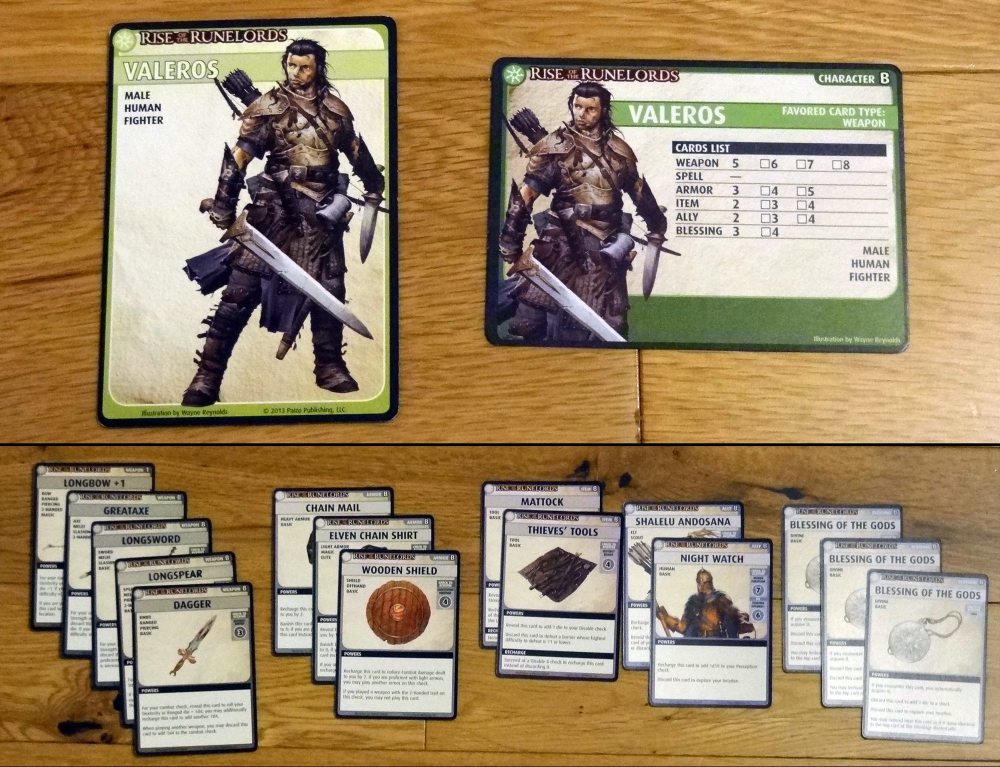
Each character starts off with a deck of 15 cards, although the mix of card types is different. Valeros has 5 weapons and no spells; Ezren has only 1 weapon but a whopping 8 spells. You can use the suggested starting decks, or you can build your own, as long as all the cards you put into it are “Basic.” Everything else you have to earn.
As you play through a scenario, you may acquire new items, weapons, allies, and so on. At the end of the scenario, however, each player has to match their list of card types again. So you can swap out for a better weapon but you can’t have more than what is listed. You’re also allowed to trade cards with each other for the best combination of decks.

When you successfully complete scenarios and adventures, you also earn feats–this is where your character really levels up. You may have noticed the checkboxes on the character cards: these are the various feats you can earn. Of course, it’s likely most gamers won’t want to write directly on the cards, so Paizo has helpfully provided printable character sheets to help you track your stats, scenarios completed, and your deck list. Some scenarios just award random cards from the box that you’ll be able to choose from when setting up your deck for the next scenario, but there are skill feats, power feats, and card feats. These increase your stats, improve your powers, and give you more card slots in your deck. However, these feats don’t come cheaply, so you’ll have to choose wisely to decide which boxes to check.

After the third adventure pack, you’ll eventually get to choose a role, which lets your character specialize even further. Each character has two roles to choose from, giving them different powers. Some of the differences are subtle, and others are more obvious, but once you’ve chosen a role then that choice becomes permanent for that character.
Finally, I should mention death. If you die during a scenario, then you lose all of those wonderful upgrades. The rest of your party (assuming they survive) can loot your deck for cards later, and you’ll have to start a new character. So far I’ve died once–I think it was the collapsed ceiling that really did Ezren in. Fortunately he hadn’t leveled up much yet, so it wasn’t a great loss. I’m being a little more careful with Valeros now, though he seems to have a tendency to fall into Pit Traps.
Time for Adventure
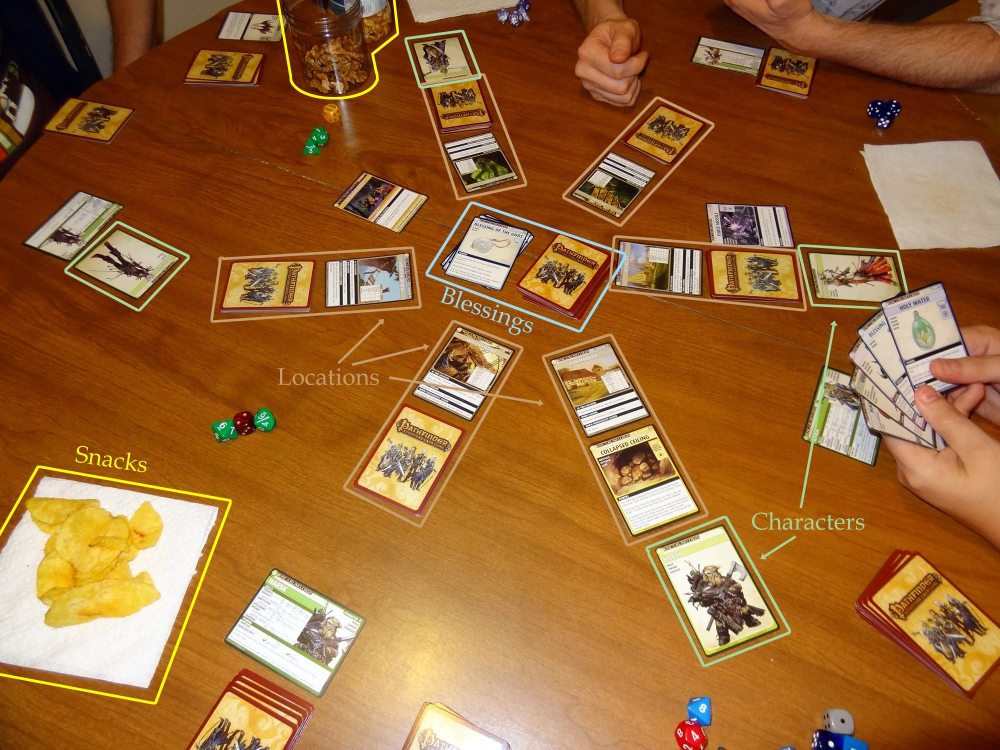
Each scenario has a card that tells you which locations to use (based on number of players) and any ongoing effects during the scenario. In turn, each location card has a list showing how many of each type of card you’ll add to its deck. So if it says it has 4 monsters, you’ll shuffle the monster deck and randomly draw 4 for that location. In addition, each scenario has a villain and its associated henchmen. You take the villain and then the appropriate number of henchmen so that each deck will have one or the other. The idea is that the villain is hiding out in one of the locations, and there are henchmen in all the others. Your goal is to find and defeat the villain before time runs out.
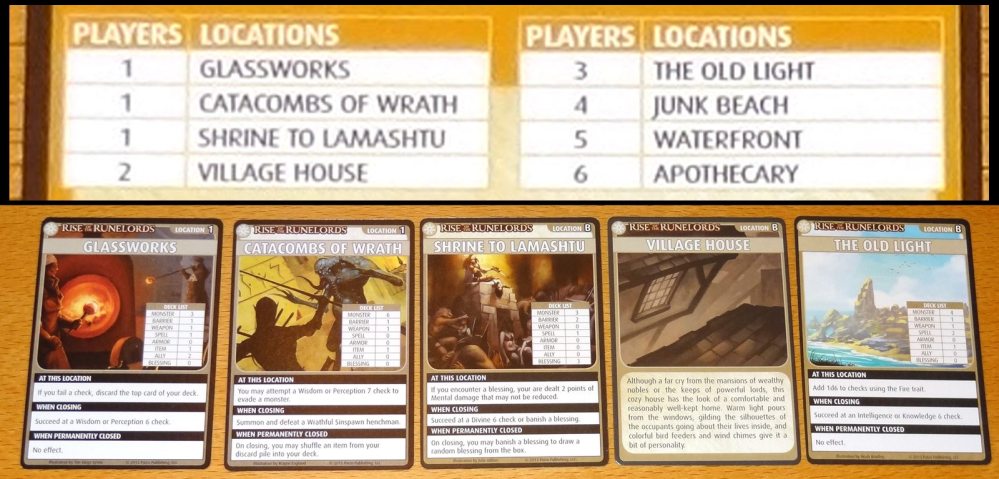
Each deck will end up with 10 cards, including the villain or henchman, but they’ll have a different mix of monsters, items, spells, and so on. The more players you have, the more locations there will be–but the trick is that you’ll have 30 turns to finish regardless of the number of players. The timer is represented by the Blessings deck (in the center of the setup photo above). You have 30 random blessings in the deck, and at the start of each turn you flip over the top card. Run out of cards, and you lose the game.
On your turn, you can give a card to somebody at your location, move somewhere else, and (most importantly) explore your current location. To do that, you simply flip the top card and encounter it. Whether it’s a bane (something bad) or a boon (something good), you roll dice to see if you defeat or acquire it. The number in the circle in the top right indicates the number you have to match or beat to be successful, and printed above that circle is the type of stat you need: Intelligence, Strength, Dexterity, etc. You check your character card to see what sort of dice you’ll roll for that stat, and you can also use cards that will help you increase either the number of dice rolled or the results.

Various cards work differently. For example, most weapons just require you to reveal them to use them, but some also allow you to discard them for additional bonuses. Spells are generally discarded after one use, but you can pass a “recharge” check to put them back at the bottom of your deck. Blessings always let you add a die to your roll; some add two for specific checks.
When you have a combat (against a monster, henchman, or villain) you’ll take damage if you don’t roll high enough–the amount of damage is the difference between your roll and the number you needed. Barriers can also cause damage, but there are some barriers that can be good: locked chests can reward you with weapons or items if you can get them open.
The way damage is handled is pretty ingenious: you discard cards from your hand. Your deck represents your hit points: at the end of each turn you draw back up to your hand size, and if you ever run out of cards–you’re dead. If you don’t have any cards to discard from your hand, then you don’t take any more damage. This is interesting because Valeros, who starts with a hand of 4 cards, doesn’t have as many options but you know he will usually only take at most 4 damage on any given turn. Ezren, on the other hand, starts with 6 cards–he has a lot of flexibility but he can also die easily.
You get one free exploration per turn. There are other cards (like Blessings and some Allies) which let you explore again, and it’s often a good idea unless you’re low on cards, because you need to find the henchmen and villain before that timer deck runs out. Some locations also have specific effects that let you explore again as well. Once you’re finished with your turn, you draw back up (or discard down) to your hand size, and it’s the next player’s turn.
Winning the Game
The ultimate goal of the game is to find and defeat the villain–and then you’ve completed the scenario and gain any associated rewards. But it’s not as simple as just passing a combat check against the villain.
There’s one other key mechanic: closing locations. Basically, closing a location prevents the villain from sneaking off to it later, because you can’t actually defeat the villain unless there’s nowhere left for it to run. Each location has different closing requirements: some may have you fight a particular monster, or banish a card (taking it out of your deck). Sometimes you have to pass a particular skill check. The only times you may attempt to close a location are (1) after you defeat a henchman, (2) after there are no more cards in the deck, or (3) right before somebody at another location is about to fight the villain. In this last case, the location is only temporarily closed, and will reopen after the villain encounter is resolved.
When you defeat the villain, that location is automatically closed, and then it will run away to a random open location (if there are any). You get to shuffle the villain with enough blessing cards from the box so that there’s one card per open location, and then shuffle them into the location decks. If you don’t defeat the villain, it still runs away, but this time the blessing cards come from your Blessings deck–effectively running down the clock. In order to win, you have to defeat the villain when there are no other open locations.
The Verdict
As I stated at the beginning of my review, I’ve been obsessed with Pathfinder ACG. For me, it has hit a great blend of RPG elements and game mechanics. One of the main reasons I haven’t played much RPG is the difficulty of getting the same group of players together for multi-hour sessions, but I’ve actually made that work a few times for this game, and I’ve now started a regular weekly session to get through the first adventure. Before this, I’ve never really attempted that.
Because the game is based on the Pathfinder RPG system (which in turn is based on D&D 3.5), it feels familiar, from the types of characters and monsters you’ll encounter to the weapons and spells and items. Things generally make thematic sense: to avoid a pit trap you’ll need dexterity; to attract a new ally you may need charisma or diplomacy. Yes, there’s a lot of reading to be done on the cards, especially at first, but as you find favorite weapons and spells you’ll remember how to use them.
I do wish that there were a little more flavor text on some of the cards. Right now, the adventures, scenarios, heroes, and locations all have blocks of text on the card backs that fill in some story. Some of the villains have just a line of text as well, but otherwise you don’t see a lot of text on the cards that adds to the theme. Granted, the cards are pretty text-heavy already, but I think it would have been nice to have a little bit more on special items and weapons, or some of the unique named allies (as opposed to the generic guard, soldier, etc.). When fellow GeekDad Erik Wecks joined us for one scenario, he was able to fill in a little more story since he had come across some of the locations and characters while playing the RPG–but for those who are starting with the card game, there will be some story elements that you’ll miss out on.
The replay value is pretty high, because of the way the game can change each time you play through it. I don’t mean that in the sense that you’ll roll different numbers on the dice or draw different cards (though that’s true), but that your character can be either slightly or totally different on subsequent playthroughs. It’s a little bit like Risk Legacy, in that as you progress through an adventure you’ll play slightly different versions of the same game–your character develops, you get better cards in your deck, and you shift to different scenarios. That leveling up is probably what makes it so tempting to start another game as soon as you finish: Hey, now I’ve got this Flaming Mace, and I can’t wait to use it on something!
With new adventure packs planned every two months, you’ll have enough to keep your adventuring party busy for a year, even if you don’t repeat scenarios. I do wonder what it will be like replaying the adventures once you’ve already completed them, though. So far I’ve actually played some of the opening scenarios multiple times since I was running the game for a couple groups, and it was pretty fun getting to switch characters to see how it played with a different team. Now that I’ve purchased the Character Add-On deck as well, I’m almost eager to start over again even though I’m only halfway through Adventure Deck 1. So I imagine that even without new adventure decks, I’ll still be pretty happy playing the base set for some time before I got bored with it.
The downside may be dealing with character death. If you run out of health during a scenario and you have no way to resurrect (which is apparently pretty rare), then you’re supposed to just toss that character deck and start over. This may not be terrible if you’re playing solitaire, but if you’re playing with a group and you’re already five scenarios in, you’ll have to make a choice whether to play through several scenarios alone to catch up, or to just build a character deck and pretend that you’ve earned some of the level-up rewards. So far I’ve only lost one character, and that was in the base set adventure so I hadn’t actually earned any feats yet. I imagine that if we lose somebody who has increased stats it’ll be a little more painful.
Ultimately, though, what I like most is just that it’s fun. Even without the flavor text and a game master, the game lends itself to telling stories. In our games, Seoni has shown herself adept at tracking down the villain nearly every time we play. Valeros, unfortunately, just can’t avoid falling into pit traps, even with the Boots of Elvenkind he picked up. (Hint: they only help if you’re actually wearing them.) And Lem the bard–well, let’s just say that in some scenarios our halfing did all the heavy lifting.
Each time I’ve gotten my group together to play, we never want to quit after just one scenario. That may be the best praise I can give it: I’m somebody who tends to play as many different games as possible, but in the past few weeks I’ve played Pathfinder ACG multiple times in a weekend–in a day, in fact–and I’m still looking forward to my next session.
The Pathfinder Adventure Card Game retails for $59.99, the Character Add-On deck retails for $19.99. Additional adventure decks will also retail for $19.99, or you can buy an ongoing subscription from Paizo to save 20%. The game is for 1 to 4 players (up to 6 with the extra character set), and plays in roughly an hour to 90 minutes (depending on the number of players).
Disclosure: Paizo provided a copy of the base set for review.
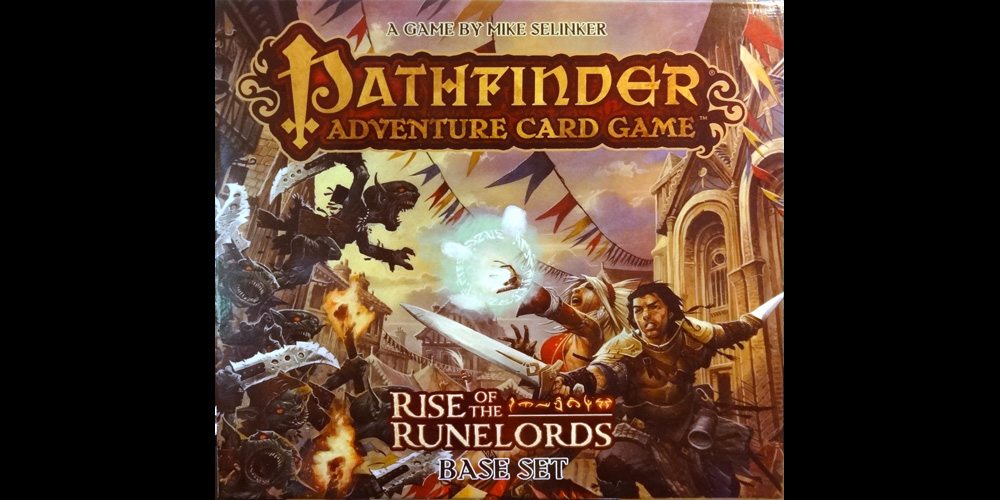
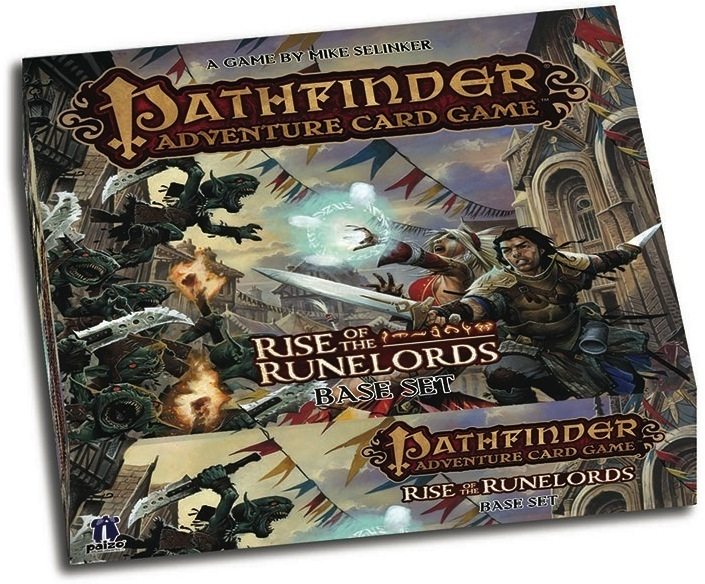

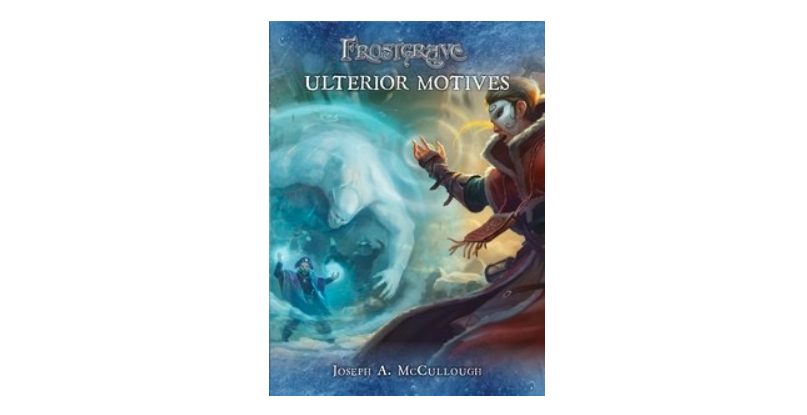
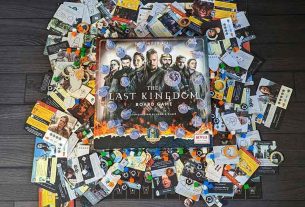
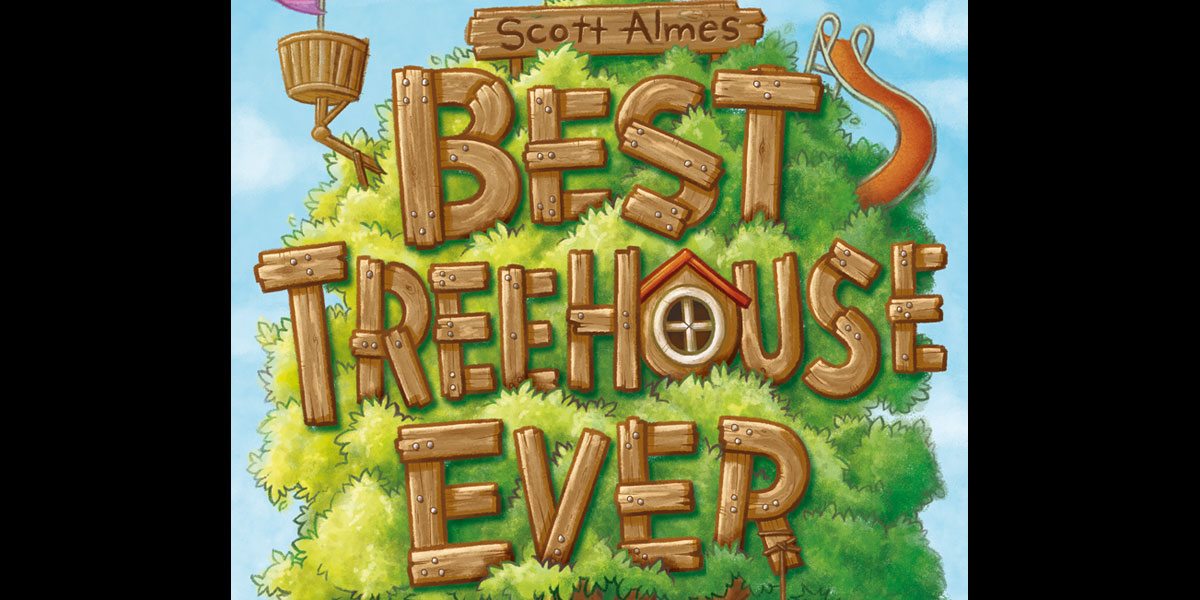
So, this being GeekDad, I was hoping to find out if this was something you have tried playing with your kids, or any kids really. Does it lend itself well to being a family adventure game where one person doesn’t have to be the GM? Have you noticed a general age range that might be able to play the game?
Hi Jason,
I just picked the game up 2 weeks ago and am having a blast with co workers at lunch. One of the first things i thought of after playing through a scenario is how great of a family game this is. NO GM is required. Rules are pretty simple. Setting up the game is the hardest part and after the first time its a breeze. It is a great introduction to traditional RPG’s. Every kid is different but im thinking it is easy enough for a 8 year old to play. That being said, the game is challenging and although the rules are pretty simple the strategy to win requires understanding the class you choose and team work. Personally the team work aspect is what makes this game a great family game.
Thank you! That is helpful info to my questions.
I’ve had this game for a week. My 12, 14, and 17 year old and I have already played through the first 4 scenarios. As soon as one session is finished they make me schedule the next one. After one player finishes the turn, they (or I) will describe what happened during the turn based on the cards and rolls. It really adds a nice touch to the game and keeps everyone entertained. A few times i have forgotten to describe my own turn and they have stopped and made me tell the story. We even give names to our allies. I highly reccomend this game for kids. My 14 year old even roleplays how dumb her character is due to her having the lowest int possible of d4. She gets a real kick out of it.